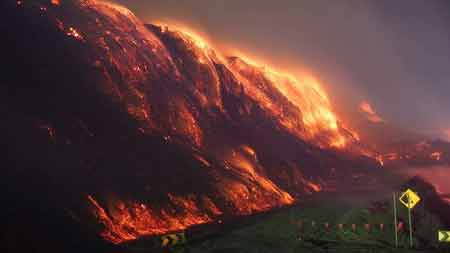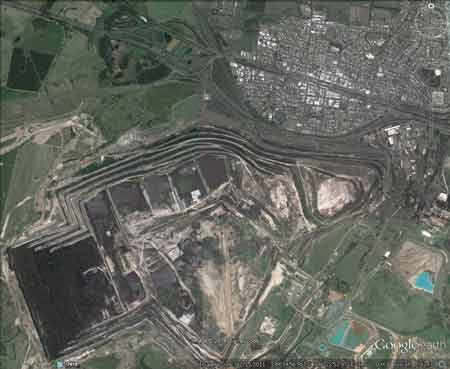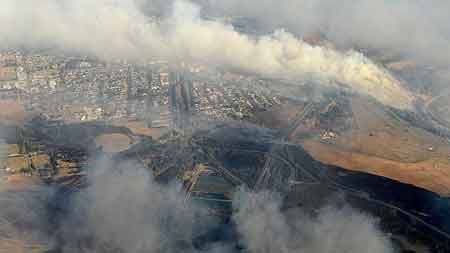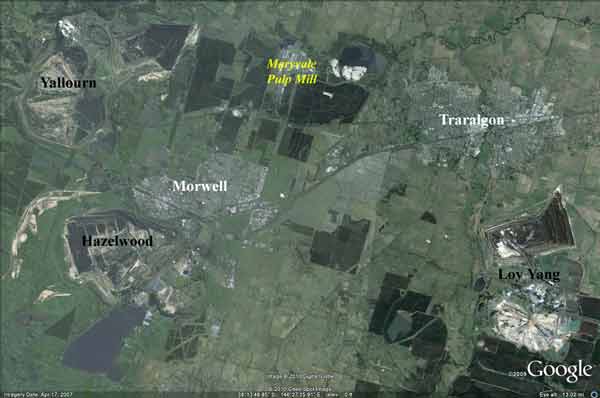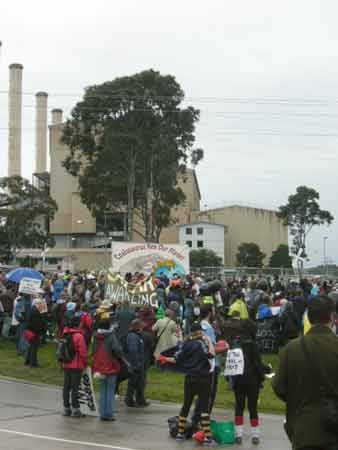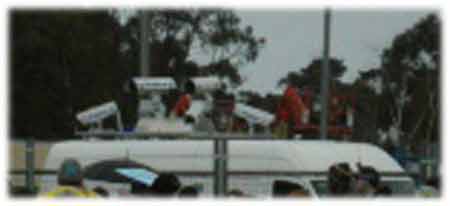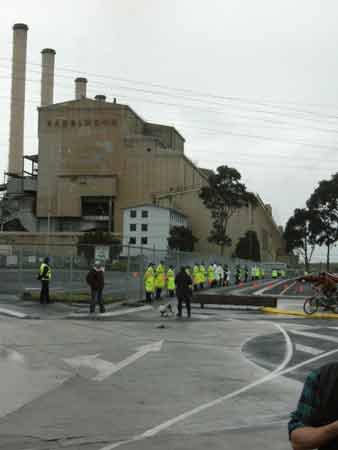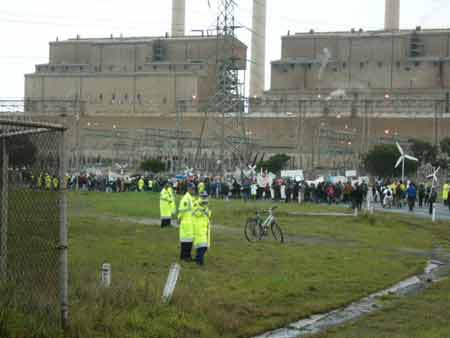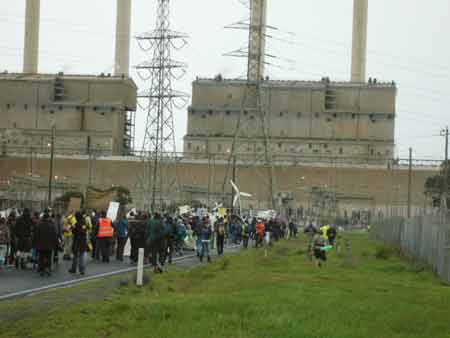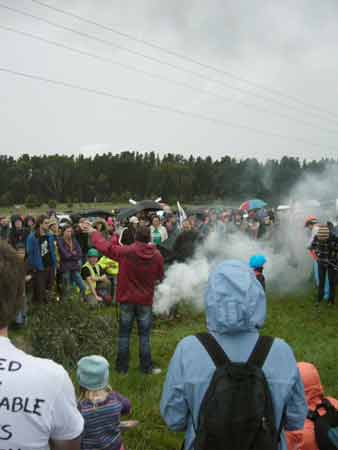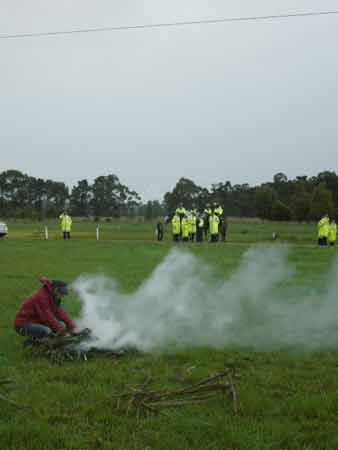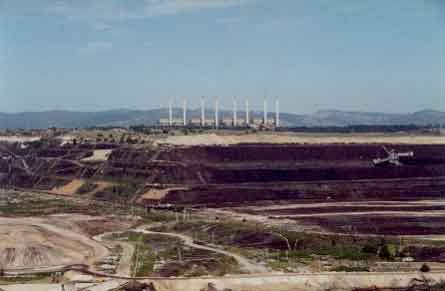EXPOSING DEVELOPERS WHO FAIL TO APPRECIATE AND RESPECT COMMUNITY, ENVIRONMENT AND SPIRIT OF THE LAND
HAZELWOOD COAL: AN INDUSTRIAL DINOSAUR
"Quit Complaining Privatisation Is Really Good For You!!!?"
Who Are GDF Suez?
Hazelwood Mine Fire Inquiry
Morwell Neighbourhood House List or Articles on Hazelwood Mine Fire
Hazelwood Mine Fire Feb 2014: Photo Keith Pakenham
Proximity of Morwell to Hazelwood mine. Some homes are 500m from coal mine. Interesting that in 2011 the Baillieu Liberal Government imposed tough 2km restrictions on wind turbines, but have remained mute about the proximity of coal mines to thousands of people.
July 23 2015: Hazelwood Considers Clean Energy Biomass Burning Option (another dumb idea)
July 16 2015: Latrobe Valley Residents to Present GDF Suez with $18m Invoice for Coalmine Fire
July 8 2015: GDF Suez refuses to pay Hazelwood coalmine fire bill
June 26 2015: Man Charged Over Blaze Linked to Hazelwood Coal Mine Fire
May 26 2015: Reopening of Hazelwood Mine Fire Enquiry
April 27 2015: Mine Rehabilitation to be a Focus of Reopened Hazelwood
Jan 23 2015: Tough Regulations Follow Hazelwood Coal Mine Fire Inquiry/6042088
September 15 2014: Rethink Needed on Hazelwood Mine Fire
September 12 2014: Hazelwood Mine Fire Pollution Blamed for 11 Deaths
September 12 2014: Coroner Considers Hazelwood Mine Fire Inquiry
August 4 2014: Morwell Residents Threat to leave after Mine Fire Flare-Up
August 4 2014: Spot Fire Extinguished
June 18 2014: Morwell Health Study should be extended Inquiry Counsel urges
June 7 2014: Hazelwood Coalmine Operator GDF Caught Flatfooted Fire Inquiry Told
June 2 2014: Victorian Coalmine Fire Made Us Sick to our Stomachs Say Residents
May 26 2014: Coal Mine Fires Commonplace Hears Inquiry Into Hazelwood Blaze
May 7 2014: Hazelwood Coal Mine Fire Hotspots Remain
March 15 2014: Morwell Mine Floats Plan For Lake
March 10 2014: Morwell Mine Fire Declared Controlled
March 10 2014: Napthine To Outline Inquiry Into Morwell Mine Fire
March 8 2014: Why Morwell is Burning
March 7 2014: Morwell Fire Sparks Calls For Tighter Regulation
March 7 2014: Tests Reveal Toxic Bacteria In Water Used to Fight Hazelwood
March 4 2014: Sorry Hazelwood Coalmine Owner Says It Has Nothing To Hide
March 3 2014: Doctors Warn Residents
March 3 2014: Three-week blaze leaves residents angry, sick and demanding answers (7.30 Report)
March 1 2014: We Can't Sleep, We Can't Breathe
February 28 2014: Premier Denis Napthine backs Victorian health officer's decision on warning
Victoria's top health officer has defended the decision to wait until almost a month after the Hazelwood coal mine fire began to upgrade the health warning for Morwell South.
February 28 2014: Morwell Smoke Like London Smog Disaster
But experts are warning that severe air pollution from the coal mine fire should be taken far more seriously because it bears comparisons to a 1952 coal smoke disaster. In that event, Londoners were blanketed in black coal smoke and smog for several days, killing an estimated 12,000 people. Queensland University of Technology Professor Lidia Morawska, an expert on air pollution, said it isn't right to classify Morwell's smoke pollution as a short-term event and therefore as having little impact on health. "The London fire duration is comparable to the Hazelwood fire," she said. "There are many examples of health impacts due to much shorter exposure to combustion products than this fire." Adrian Barnett, a QUT associate professor in health, said the dangers of coal smoke have been known for years due to epidemiological studies on the London smog. "If I lived in the area I would move my family away until the fire was out," he said.
February 28 2014: Anger Erupts As Authorities Advise Relocation From Smoke Hit Morwell
THE elderly, young children, pregnant women and people with lung problems are being advised to leave the worst-affected area near the Hazelwood coal mine fire, in a major escalation of the crisis in Victoria’s Latrobe Valley. The move comes amid growing alarm in Morwell over rising carbon monoxide levels, ash and smoke from a fire that’s been burning for almost three weeks. Authorities are advising vulnerable residents in the southern part of Morwell to move temporarily, with the fire in the open-cut mine expected to continue to blanket Morwell in thick smoke and ash for at least another 10 days. However angry locals heckled Victoria’s Chief Health Officer Rosemary Lester during her announcement, which she says follows consistently poor air quality in Morwell South.
February 28 2014: Vulnerable residents Advised to Relocate
February 27 2014: Hold Your Breath
February 27 2014: Call For Enquiry Into Hazelwood Coal Mine Fire
February 27 2014: Smoke From Hazelwood Coal Mine Forces Local Protest
February 27 2014: Morwell Fire Beyond Comparison
February 27 2014: Mine Operator Asked To Help Pay For Morwell Firefight
February 27 2014: Morwell Resident Expects Costly Insurance Claim For Clean Up From Hazelwood Mine Fire
February 27 2014: Morwell Residents Scared To Stay But Unable To Leave As Coalmine Fire Burns On
February 26 2014: Morwell Residents Consider Class Action
February 26 2014: Arsonist Behind Morwell Mine Blaze Has Knowledge Of Fire Behaviour Police Claim
February 25 2014: Police Suspect Arsonist Behind Hazelwood Open Cut Mine Fire
February 25 2014: Coal Mine Fire Burning Hole in Morwell Locals Housing Prices
February 25 2014: Morwell Health Expert Says No Long Term Risk
February 24 2014: Keep Records Respiratory Lawyer
One of the most experienced asbestos lawyers in Australia is advising Latrobe Valley residents to document their health problems amid the smoke crisis. Slater and Gordon practice group leader in respiratory disease Steve Plunkett said smoke-affected residents should document their exact symptoms, how they were exposed and the amount of dust in their homes. Mr Plunkett said Valley residents were "absolutely, without a shadow of a doubt" justified in their health concerns over the Hazelwood open cut fire. "I've been doing respiratory disease for more than 30 years and any foreign particle dust is bad for you," Mr Plunkett said. "It's brown coal, it's got all sorts of carcinogens in it. "It seems to me if it did turn out to be bad for people's health, that authorities might have a case to answer in not acting quicker."
The Department of Health Victoria's chief health officer Dr Rosemary Lester last week moved to reassure the community, saying she did not expect to see significant long-term health impacts as a result of the air quality situation. "For them to be saying it's safe is nonsense, because they don't even know what's in it," Mr Plunkett said. "It wasn't that long ago (people) were saying asbestos was fine and we all know what a debacle that turned out to be." Mr Plunkett said if the smoke was found to be harmful, the department's comments could be found to be negligent.
The Morwell-based lawyer said his firm had received multiple phone calls from residents concerned because "they don't know what they're breathing in". "I myself am worried about it," he said. Mr Plunkett said air purifiers were operating in the Slater and Gordon Morwell office on George Street. Maurice Blackburn Gippsland principal Gino Andrieri agreed concerned residents should keep records. "It is a prudent measure, because if something eventuates and they're diagnosed, the nature of these sorts of medical issues can occur years down the track," Mr Andrieri said. He said it was difficult to say whether claims would likely be made in future. "You first have to prove something has been done wrong. How have the fires been managed? Could they have been put out earlier? Could the community have been warned earlier?" Mr Andrieri said. "If something is arguably done wrong, you then still need to prove the smoke exposure has played a part in diagnosis and that's where records become very important." He said along with documenting exposure and symptoms, concerned residents should visit their doctor.
February 24 2014: Call For Independent Inquiry Into Morwell Coal Mine Fire
February 24 2014: State Government Managing Health Risk of 'Deeply Unpleasant' Morwell Fire: Minister
February 24 2014: Minister Rejects Fire Health Risk
February 22 2014: Gigantic Crack Appears in Hazelwood Mine
February 21 2014: Centre Opens To Address Smoke Concerns For Morwell Residents
February 21 2014: Air Quality Has Deteriorated Dramatically At Morwell in Latrobe Valley
February 20 2014: Locals Criticise Mine Owner Over Morwell Fire (7.30 Report)
February 20 2014: Heat To Rise On Hazelwood
THE management of the Hazelwood mine and its regulation by government is expected to come under fierce scrutiny in coming weeks, as questions arise over the mine's fire preparedness prior to the current emergency.
With limited progress being made 10 days into the firefight, frustrations are peaking over the mine's conditions before the fire outbreak on 9 February, with stakeholders and observers labelling the affected site's former state as "an unacceptable fire risk".
Numerous firefighter and mining insider sources have agreed in separate interviews with The Express the combination of unused mine batters left exposed to the elements for decades without rehabilitation, and the lack of firefighting water pipelines in the affected mine area, had largely inflamed the current blaze.
Another inside source described the removal of water mains in the late 1990s and early noughties from the affected section of mine the symptom of "blatant cost cutting" and a lasting legacy of the privatisation of the power industry.
"If they had adequate pipelines in place, they wouldn't be this deep into the situation as they are now - they have taken a big risk here, and it's come back to bite them and everyone in the community," the source said.
Only 400 metres south of the Morwell township, the fire has entrapped residents in an unrelenting cloud of raw coal fire smoke, broken air pollution records and thrown the community into a public health emergency.
With a 1.2-kilometre, 300-millimetre water main line still hastily being constructed by mine operator by GDF Suez Australian Energy to the firefront, and windy conditions still to come, the CFA has predicted the firefight will last weeks.
Construction, Forestry, Mining and Energy Union mining and energy president Luke van der Meulen said on ongoing regime of cost cutting at the operation had created an "negligent risk to the community".
"The company is operating in a financially constrained time and will always try and do the things that Hazelwood does - but the only thing that prevents that is regulation, which clearly hasn't been going on here," Mr Van der Meulen said.
"The government has been asleep at the wheel for a long time, and I think there has been far too cozy a relationship between regulators and these power corporations and no one from the community gets a look in to this."
However a spokesperson for GDF Suez said the fire preparedness of the mine had nothing to do with cost cutting.
"GDF SUEZ Hazelwood has a comprehensive fire prevention and protection strategy in place in the Morwell mine to protect this critical infrastructure," the spokesperson said.
"It is important to remember that this fire started outside the mine in quite extraordinary weather conditions that posed a threat, not only to the mine but to large parts of the surrounding farmland and communities."
However Monash University environmental engineering senior lecturer Gavin Mudd said mine management should have been far better prepared for the risk of fire spread from neighbouring grassfire.
"That entire section of mine has been unused for years - decades in some areas - it should have been completely rehabilitated by now with a clay or soil cover - the question is whether they've been allowed to constantly defer the capping of those mines under their mining licence requirements," Dr Mudd said.
"Either the regulation on the mine in terms of rehabilitation is far too lax, or the policing of it is just not happening - but either way there's clearly been a major stuff up somewhere."
Attempts by The Express to clarify which regulatory authority was ultimately responsible for policing the suitability of fire services in the mine were unsuccessful, receiving different responses from different government departments.
A spokeswoman for Energy and Resources Minister Nicholas Kotsiras said all arrangements relating to fire prevention at mines were regulated by fire authorities. Fire Services Commissioner Craig Lapsley said emergency authorities had input into the development of occupational health and safety plans and the associated emergency management plans - which covers fire fighting infrastructure within the mine - but it was regulated by WorkSafe.
A spokesman for the Victorian WorkCover Authority said the mine operator was required to have an emergency response plan in place for issues such as fires, developed in conjunction with the emergency services and the local council.
"The VWA may review this plan as part of its regulatory function," the VWA spokesperson said.
In response to rehabilitation concerns, the GDF Suez spokesperson said the company was "comfortable" it had worked closely with the State Government in adhering to mining licence requirements.
"Pipelines have not operated in the northern batters area of the mine for 40 years or more as this is not an operational area of the mine. Some inoperative pipelines were removed to enable rehabilitation programs to proceed," the spokesperson said. "Rehabilitation of the Morwell mine is an ongoing process, with some of the areas on the northern batters where the fire has been burning already rehabilitated."
However the spokesperson could not clarify how much of the dormant section of mine had been rehabilitated.
Environment Victoria's acting chief executive Mark Wakeham said the whole situation called for a public inquiry into what had contributed to the incident's severity and its impact on the community.
"There seems to be a persistent and patented culture of failure in regulation of the oldest mines in the Valley, where the regulator appears ill-equipped or disinterested in doing anything about it," Mr Wakeham said.
"The public deserves to know whether it's the company's failing to meet requirements government has set for them or whether the government is not setting adequate benchmarks for the operation.
" Mr Kotsiras' office said all government agencies were entirely focused on putting out this fire and dealing with the impacts on the community, and government would assess and review the incident after the situation was brought under control.
February 17 2014: Dangerous Gas Could Spike Again (Latrobe Valley Express)
Image ABC
Morwell residents could be exposed to elevated levels of the dangerous gas carbon monoxide for weeks, the CFA has warned, after levels spiked in the township on Saturday.
With the Hazelwood open cut fire predicted to last weeks, carbon monoxide created by the blaze could continue to linger in residential areas in calm weather, according to a CFA update issued yesterday.
"(When there are) no winds to disperse smoke... it is possible that this will happen again until the fire is out," the CFA bulletin stated.
Anxiety swept through much of Morwell's population on Saturday after a carbon monoxide alert warning was issued at 12.59pm for the town, recommending residents west of McDonald Street and Maryvale Road to shelter indoors.
Residents were advised to ensure all external doors, windows and vents were closed, and to switch of heating and cooling systems.
At 3.30pm the 'watch and act' alert was downgraded to an advice level, notifying residents it had become safe to ventilate houses, however with thick smoky conditions prevalent throughout the afternoon, social media was alight with concern as to whether it was safe to do so.
Carbon monoxide is an invisible odourless by-product of burning fuel and exposure symptoms include tiredness, headaches, dizziness, nausea and confusion, according to the Victorian Government's Better Health website.
With the CFA predicting "at least several weeks of work ahead" in the fight to extinguish the blaze, emergency services HazMat technicians will continue to monitor carbon monoxide levels in Morwell and issue further warnings if and when required.
About 20 firefighters are now believed to have attended hospital with exposure symptoms or concerns after working at the open cut blaze, which has become a carbon monoxide sinkhole since the fire broke out on 9 February.
When asked last week if residents would be at risk to the increased carbon monoxide levels, emergency and monitoring authority spokespeople said on a number of occasions the Morwell township would not be affected.
Meanwhile, with the absence of wind at the weekend, the lingering smoky conditions reached some of their worst levels since last Sunday, creating a thick plume over the town and reducing visibility at some points to less than a kilometre.
Air monitoring data from the Environment Protection Authority showed air quality index ratings were blown off the charts at the weekend, with Morwell returning a reading of 459 on Saturday between 3pm and 4pm, more than three times the threshold for its worst quality rating, 'very poor'.
Living with emphysema, 77 year-old Maryvale Crescent resident Ron Beveridge said his ability to cope with the worsening conditions was "bloody shocking".
"All this bloody smoke is killing me - I'm seizing up in the back of the throat and the house smells bloody terrible," Mr Beveridge said, adding a recent heart bypass operation was not helping. "When I heard about (the carbon monoxide) on the radio I closed all the windows and locked the doors to stop it coming in, but I'm in these commission flats with three-inch wire vents you can't close, so it would have still been getting in."
While Mr Beveridge said he had been coping throughout last week, the worsening conditions - which he described as "a thick London fog descending over Morwell" - had become unbearable.
"The nights are the worst - I got up to have a sleeping tablet (Saturday) night and that didn't even work - I had to plant a fan beside the bed just to make it easier to breath," he said. "On top of all this, the dog has been annoying... me because I haven't been able to take him for a walk for three days."
A CFA community information bus was set up in Morwell yesterday to answer residents' concerns.
EPA field operations group manager Elizabeth Radcliffe advised residents they could conduct a smoke assessment themselves, without need for any monitoring equipment.
"If you can see 20 kilometres in front of you the air quality is good. If you can only see 10km in front it is poor and that is the stage when alerts are issued," Ms Radcliffe said. "If visibility is less than 1km then (the air) is hazardous and you should be limiting your exposure as much as possible."
Signs of smoke irritation include itchy eyes, sore throat, runny nose and coughing, while worsening symptoms may include wheezing, chest tightness and difficulty breathing; children, elderly and those with pre-existing illnesses are more vulnerable.
February 17 2014: Firefighters Falling Ill At Coal Mine Fire
February 17 2014: Vic Coal Mine Fire Could Burn For Weeks
February 14 2014: CFA volunteer claims firefighters we were not safe at Hazelwood mine fire
Poisoning conditions in Hazelwood mine (Source: Latrobe Valley Express Feb 13 2014)
THE nightmarish firefight at the Hazelwood open cut suffered a serious setback yesterday after seven volunteer firefighters were taken to hospital for carbon monoxide poisoning.
With the battle against two major coal mine fires within the Morwell open cut expected to last weeks, the firefight's operational processes and protocols were undergoing a major procedural overview yesterday afternoon.
The firefight, led by the CFA, was dramatically scaled back as a result of the hospital admissions, with priority being placed on protecting critical infrastructure within the mine.
Incident controller Peter Lockwood confirmed the affected firefighters had been operating within the mine without breathing apparatuses, which had until yesterday been an accepted part of the firefight's procedure.
"We are very, very concerned by the fact that this has occurred," Mr Lockwood said. "This type of fire is unique - these carbon monoxide-rich environments are not something which happen everyday."
However Mr Lockwood said firefighters had fought a similar coal mine blaze at Hazelwood in 2008 without widespread BA use, and avoided any adverse health impacts.
He said all firefighters were now being tested for carbon monoxide exposure before and after shifts, and extra breathing apparatus equipment was being sourced from across Victoria.
However it was unknown yesterday afternoon where the volunteers were from.
Lighting on Sunday, after the Hernes Oak fire spotted before the south westerly wind change, the Hazelwood fire has established in two separate locations within an inactive section of the mine.
An 800-metre long fire remains alight along the mine's northern batter wall, and a separate fire on the eastern batter stretches some 500 metres.
GDF Suez Australian Energy head of generation Luc Dietvorst said while the situation had been brought under control following "really bad" circumstances on Sunday, extreme care was being taken to ensure the eastern batter fire did not spread into the operational sections of the mine.
The Express was given first hand access to the response area yesterday when accompanying Premier Denis Napthine as he visited the Incident Control Centre perched above the mine's eastern rim.
Standing among the staging area where about 15 CFA appliances were parked at the ready, visibility into the mine was at a minimum; the mine's smoky abyss was broken only momentarily as a skycrane regularly flew in to water bomb the eastern batter with water sourced from the Hazelwood Pondage.
Dr Napthine described the scene as "very eerie", however noted the calm and organised response from the emergency authorities.
"They are dealing with a very serious and complex issue here in the mine... however I am pleased to hear the affected firefighters have been discharged from hospital," Dr Napthine said.
While power generation was crippled on Sunday when SP AusNet electricity supply issues brought the mining operation to a standstill, yesterday saw the restoration of six of the station's eight generation units.
Mr Dietvorst said the two remaining generation units were expected to fire up today.
United Firefighters Union secretary Peter Marshall said the hospital admissions highlighted the "very real danger" Victoria's firefighters faced in protecting the community.
"My understanding is they will make a complete recovery, however it is extremely traumatic to suffer this type of experience," Mr Marshall said.
"Oxygen depravation is the equivalent of being smothered, and it is the equivalent of a slow lingering death."
September 6 2012: Burn On. PM's Dirty Power Buyback Plan Up In Smoke
Yallourn Mine Floods here
March 31 2012: Hazelwood Corners Bulk Of Carbon Aid
March 31 2012: Lions Share For Coal Plants Before Carbon Tax Bites
July 19 2011: Victorian Power Firms To Get 97% Of Carbon Compo
July 17 2011: Hard Sell: Gillard Clashes With Hazelwood Workers
July 12 2011: Gillard Says The Lights Will Stay After Dirty Power Plants Close
July 12 2011: Hazelwood Closure Won't Threaten Power: Swan
July 12 2011: Hazelwood May Switch To Gas Plant
July 11 2011: When It Comes To Dishing The Dirt Hazelwood's Up There With The Worst
July 11 2011: Plant Owners Open To Price Talks On Shutdown
July 1 2011: Deathknell For Dirty Hazelwood
May 15 2011: Hazelwood Man To Steer Power Policy
May 11 2011: Green Group Slam Hazelwood Decision
April 19 2011: Dirty Power stations Warning
February 11 2011: Freeway Closed Over Landslide Threat
October 15 2010: Power Station Union Lashes Brumby
October 14 2010: Dirty Coal Station Will Be Closed
October 13 2010: Federal Funding Unlikely For States Hazelwood Coal Reduction Proposal
October 11 2010: As Many Police As Protesters At Hazelwood
September 20 2010: Talks To Close Hazelwood Within Months
August 23 2010: Environment groups sceptical about Hazelwood phase-out
August 19 2010: Green MP Greg Barbers Office Supports Switch Off Hazelwood Collective
August 5 2010: Proposed Coal Plant Application Withdrawn
July 29 2010: The Clunker We Need To Scrap Is Hazelwood
July 28 2010: Yallourns Hand Up For Shutdown
July 27 2010: Jobs Fear At Hazelwood
July 27 2010: Brumby Plan Exposes Gillard
July 10 2010: Power Cut For Big Polluter Hazelwood
June 23 2010: Close Hazelwood Labor MP
May 17 2010: Push For Hazelwood Power Station To Close Early
October 28 2009: Coal Power Pollution Shock
October 25 2009: A Show of Power
October 25 2009: Changes Lock in Polluter Paradise
October 16 2009: Brumby Warned of Power Shortage
October 16 2009: Brown Coal Owners May Quit With Right Offer
October 16 2009: Polluting Plant Asks for Public Buyout
October 15 2009: Hazelwood Looking for Taxpayer Bailout of Brown Coal
October 13 2009: $14,000 Future Fines for Coal Protesters?
September 15, 2009: Hazelwood Expecting More Cimate Change Protests
September 14, 2009: Police Tactics Under Fire At Hazelwood
Switch Off Hazelwood (Direct actions planned Sept 12 & 13 2009).
September 13, 2009: Hundreds of Protesers Converge on Hazelwood
August 10, 2009: No Power To The People Says Hazelwood Chief
July 21, 2009: Victoria Proving the Dirtiest State
June 16 2009: Eco-Terror Threat Sparks Law Review
Sep 3 2007: Climate Protest Shuts Down Power Station
Who are International Power?
Link to International Power website
Hazelwood tops international list of dirty power stations click here
Hazelwood is the industrial world'smost greenhouse polluting power station, per unit of energy. Now Victoria is faced with the proposition of expanding the life of this dinosaur by five years. If approved the expansion would perpetuate Victoria's reputation as Australia's worst greenhouse polluting state and totally wipe out the greenhouse savings made by other Bracks Government policies.

Hazelwood in the foreground, located in Victoria's Latrobe Valley, with Hazelwood dam on the right. Loy Yang B, in the distance is 70% controlled by International Power.

Approximate location of Hazelwood Coal on the Australian mainland (in yellow).
REPRIEVED BY STATE GOVERNMENT? ACCORDING TO THE AGE 14/2/05; "THE STATE GOVERNMENT WILL ALLOW AUSTRALIA'S WORST GREENHOUSE POLLUTING POWER STATION TO OPERATE FOR ANOTHER 20 YEARS. THE DECISON WAS MADE BEFORE FINDINGS ON ITS ENVIRONMENTAL ASSESSMENT HAVE BEEN PROPERLY ASSESSED. . . "HAZELWOOD WILL CONTINUE THROUGH TO 2031" ENERGY MINISTER THEO THEOPHANOUS SAID. . . HAZELWOOD WAS BUILT IN THE 1960S. IT IS THE STATE'S OLDEST POWER PLANT AND PRODUCES 18 PER CENT OF VICTORIA'S ENERGY. FOR EVERY MEGAWATT IT GENERATES, HAZELWOOD PRODUCES ABOUT 1.54 TONNES OF GREENHOUSE GAS"
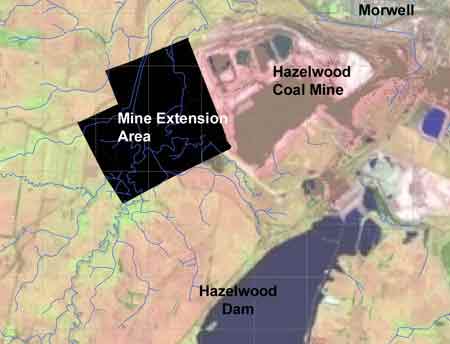
Recently approved mine expansion at Hazelwood could see the existing open cut double in size.

Victoria rates as the worst greenhouse polluting state in Australia per person and also boasts the country's most greenhouse intensive power station, Hazelwood in the Latrobe Valley.
Before the State Electricity Commission (SEC) was privatised Hazelwood, which relies on out-dated technology, was set to be scrapped. Now Victoria is faced with the proposition of expanding the life of this dinosaur by five years.
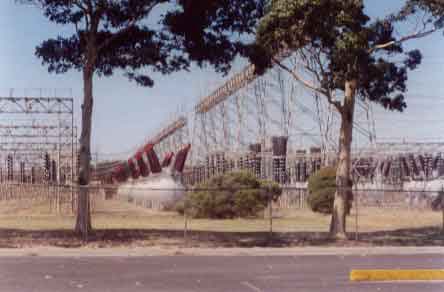
The Bracks government must refuse approval for the expansion of Hazelwood because it:
*would emit an extra 85 million tonnes (Mt) of greenhouse pollution - akin to putting 20 million cars onto Victorian roads for one year;
*would wipe out all of the greenhouse savings made by other Bracks Government policies;
*would not create a single job;
*is not needed for Victoria's energy supply;
*discourages new investment in renewables, energy efficiency and gas;
*flouts the views of the voting public who overwhelmingly supported environmental policies at the last election;
The expansion would perpetuate Victoria's reputation as Australia's worst greenhouse polluting state.
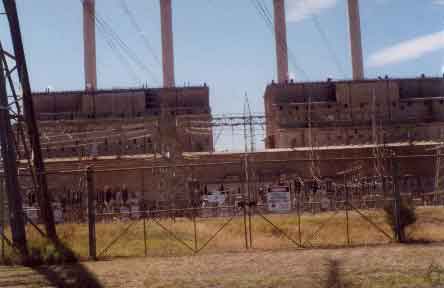
What is proposed for Hazelwood?
When Hazelwood power station was sold the effective brown coal reserves in the mining license were sufficient to operate the plant until 2022.
International Power, the UK-based company that owns 92% of Hazelwood and recorded a $236 million profit in Australia last year, now wants to extend Hazelwood's life until 2027.
It also wants to;
*relocate the Strzelecki Highway, the Morwell River, Eel-Hole Creek and Wilderness Creek.
*obtain a new brown coal mining license to extend its life.
*use coal from its current mining license for a new coal-to-diesel plant.
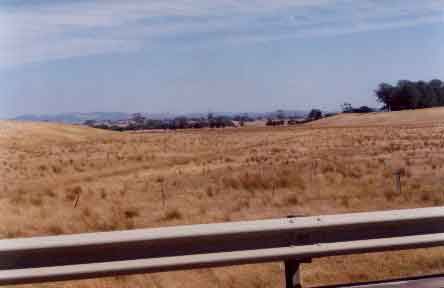
Photo above: Morwell River depression crossing under the Strzelecki Highway. Most of the land in this photo is planned to be mined for the Hazelwood expansion.
Why the Hazelwood expansion is a problem
Hazelwood produces more greenhouse pollution than any power station in Australia, per unit of energy.
It also relies on old, 1950's technology. So obsolete is the power station the SEC planned to shut it down in 2005.
According to the company's own 2002 Environment Report:
*Hazelwood's greenhouse gas emissions increased by more than 56% between 1996 and 2001.
*In 2001 the power station emitted more than 17.7 Mt of CO2, (which is equivalent to the greenhouse pollution produced by four million cars).
A five year expansion to the life of the power plant would therefore result in additional C02 emissions of more than 85 Mt.
This would totally wipe out the greenhouse savings made by other Bracks Government policies. The coal to diesel plant would make matters even worse. Producing and burning diesel from brown coal generates more than eight times the greenhouse pollution caused by burning 'normal' diesel.
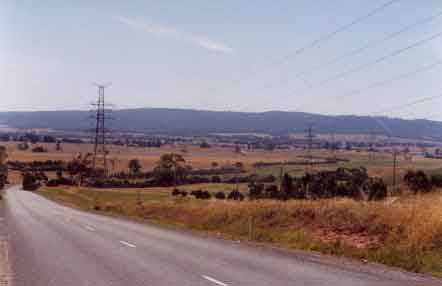
Photo above: The Morwell River catchment, most of which in this photo, will be mined for coal under the current Hazelwood expansion plans. The Haunted Hills are in the background, most of which are now under plantations and owned by the US insurance firm John Hancock Financial Services. Wilderness Creek flows from the Haunted Hills.

Photo above: Hazelwood Pondage. An artificial dam located south of Hazelwood power station. Hazelwood Pondage is sourced from cooling water recycled through the power station (sourced from Blue Rock Dam?), geothermal bore water pumped from the Morwell River Open Cut and rainwater runoff.
Hazelwood tops international list of dirty power stations - July 13, 2005
(http://www.wwf.org.au/News_and_information/News_room/View_news/223)
Victoria's outdates Hazelwood power station is the most polluting of all power stations operating in the world's major industrialised countries.
WWF has collected data on large-scale coal-fired power stations from 30 industrialised countries including Australia, Europe and the US.
The 40-year-old power station in Victoria's Latrobe Valley spews out an astonishing 1.58 million tonnes of carbon dioxide every month.
Hazelwood produces more carbon dioxide per unit of electricity delivered than the dirtiest coal-fired power stations in other leading industrialised nations - including the USA, Germany, Canada, Mexico, Czech Republic, United Kingdom, Japan and Italy.
| Country | Most Polluting Station | CO2 intensity (Mt/TWh) |
| Australia | Hazelwood, Victoria | 1.58 |
| USA | Edwardsport, Indiana | 1.56 |
| Germany | Frimmersdorf | 1.27 |
| Canada | H.R.Milner | 1.25 |
| Mexico | C. TG. Portes Gil, Rio Bravo | 1.18 |
| Poland | Belchatow | 1.09 |
| Czech Republic | Prunerov | 1.07 |
| Japan | Niihamanishi | 1.02 |
| UK | Cockenzie | 0.99 |
| Italy | Porto Tolle | 0.78 |
Hazelwood is owned by UK company International Power and was built in 1964 using technology from the 1950s.
"In many ways Australia can be regarded as a modern country that plays a leading role among industrialised nations but not when it comes to electricity generation," says WWF-Australia Climate Change campaign manager Anna Reynolds.
Despite receiving a $500 million upgrade over the past eight years, pollution from Hazelwood increased by 2.7 per cent between 1998 and 2004, according to a study by Environment Victoria (Greenhouse Pollution Intensity in the Victorian Brown Coal Industry).
Greenhouse gases such as carbon dioxide are building up in the atmosphere and causing a dramatic increase in the Earth's temperature.
Currently power stations are the world's biggest source of greenhouse gas emissions - yet in Australia their emissions are still not substantially regulated.
"Greenhouse gas pollution from coal-fired power stations like Hazelwood is driving global warming," Anna says.
"What this means for Victoria and much of southern Australia is that the climate will become drier with huge pressure on water supplies and endangered species." The Victorian Government has stated its intention to reduce the State's greenhouse gas emissions by up to 8.3 megatonnes a year by 2012.
Yet deliberations are currently being held to decide whether to extend the life of Australia's - and one of the world's - most polluting power station to 2031.
The additional pollution this would cause (an estimated 340 million tonnes of carbon dioxide) is the equivalent to putting an extra eight million new cars on the road. . .
